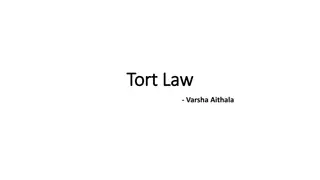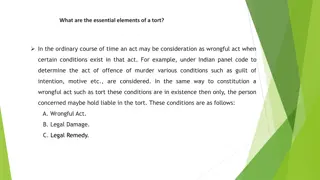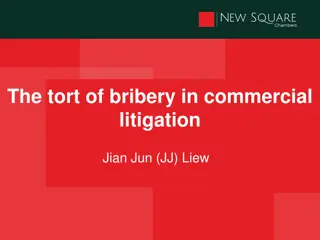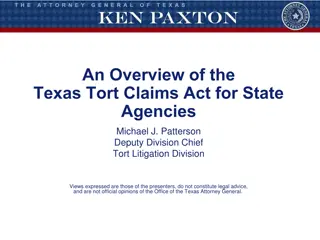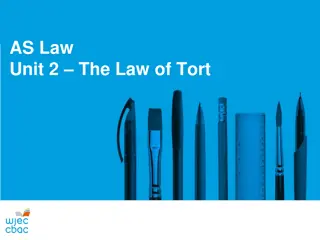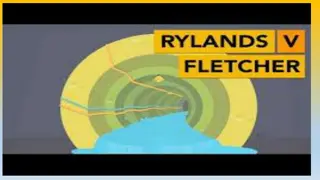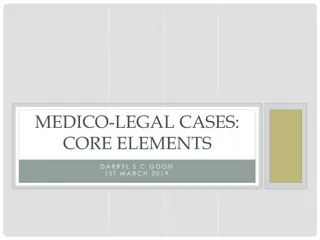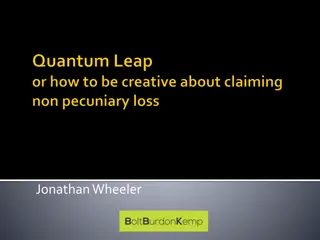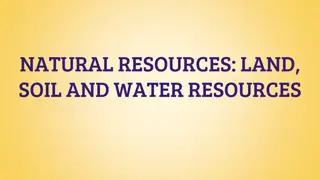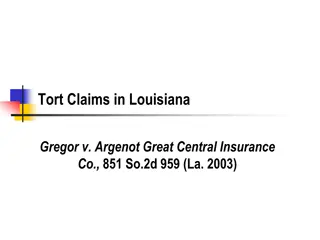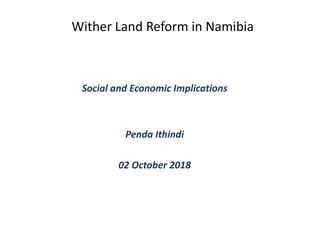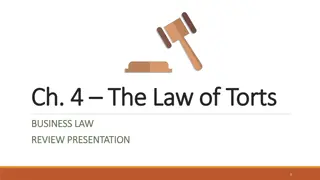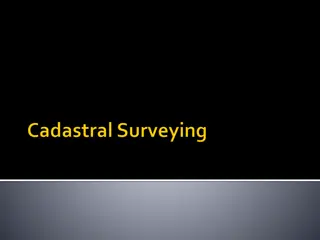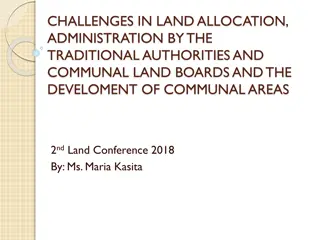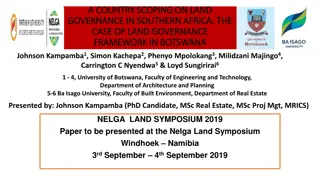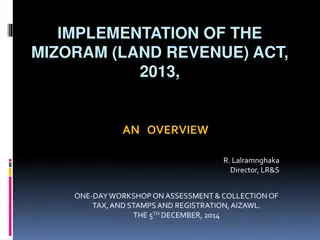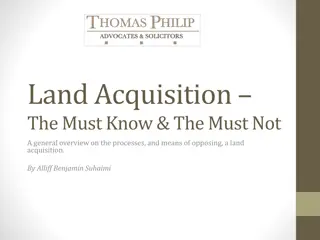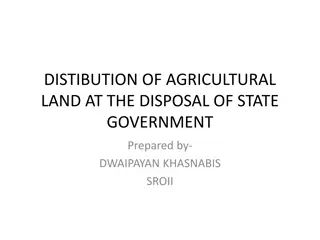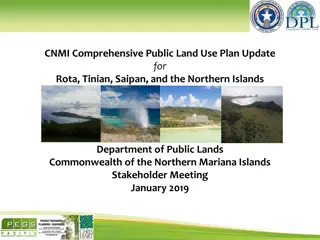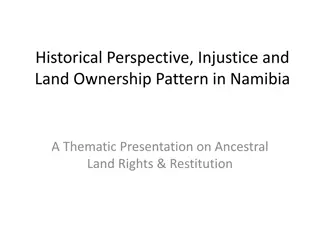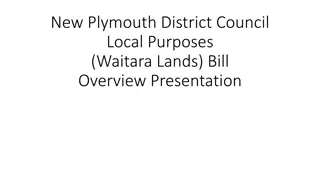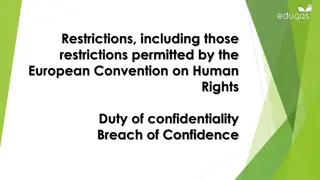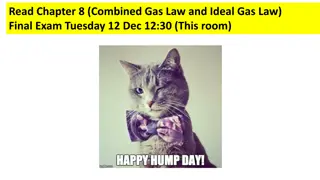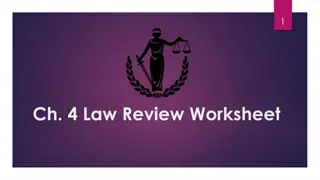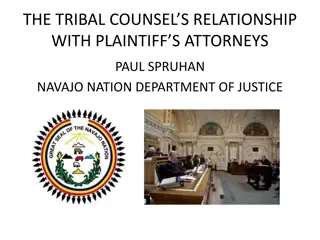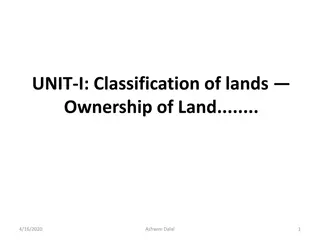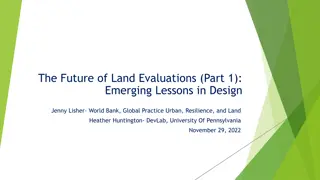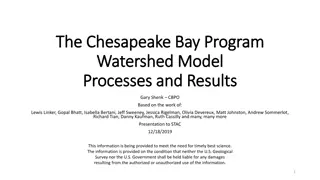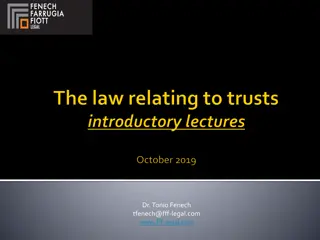Understanding Trespass to Land in Tort Law
Trespass to land involves unjustifiable interference with someone else's land in immediate possession. This type of tort encompasses direct interference with the land, voluntary actions, and potential defenses and remedies. A notable case example is Southport Corporation v. Esso Petroleum [1954], where the issue of liability for negligence versus trespass was discussed.
Download Presentation

Please find below an Image/Link to download the presentation.
The content on the website is provided AS IS for your information and personal use only. It may not be sold, licensed, or shared on other websites without obtaining consent from the author. Download presentation by click this link. If you encounter any issues during the download, it is possible that the publisher has removed the file from their server.
E N D
Presentation Transcript
Torts connected to land Trespass to Land
Learning Objectives By the end of the session you should be able to: Define trespass to land State the essential elements of a trespass to land Explain the requirement for direct interference with the land Explain the requirement for voluntary interference Explain that trespass can be innocent Explain that trespass is actionable per se Explain the main defences to trespass Explain the main remedies to trespass Identify the introduce of trespass to criminal law. 1. 2. 3. 4. 5. 6. 7. 8. 9.
A Definition Trespass to land can be defined as the unjustifiable interference with land which is in the immediate and exclusive possession of another.
The Essential Elements of Trespass to Land There are four essential elements: There is direct interference with the land 1. The interference must be voluntary 2. No need for the defendant to be aware he/she is trespassing 3. No need for the claimant to experience harm or loss. 4.
Direct Interference Trespass requires direct interference with land such as physical entry to the land, throwing something onto the land or, if given the right to enter the land remaining there, when the right has been withdrawn. For instance, if a person plants a tree and it overhangs a neighbouring property, it is indirect interference and more likely to be a private nuisance and not trespass. However, if a person cuts down a tree and throws the cut branches into his or her neighbour s garden, then it is direct interference and is likely to be a trespass.
Southport Corporation v Esso Petroleum [1954] Facts: A small oil tanker ran aground due to carrying a heavy load and a steering fault in poor weather conditions. Oil was deliberately discharged in order to free the tanker. The oil drifted onto the claimant s land and a marine lake. The claimant brought an action for nuisance, negligence and trespass. Held: The Court of Appeal decided by 2:1 that the defendants were liable for negligence.
Southport Corporation v Esso Petroleum [1954] Denning LJ stated that the defendants were not liable for trespass because: [t]his discharge of oil was not done directly on to their foreshore, but outside in the estuary. It was carried by the tide on to their land, but that was only consequential, not direct. Trespass, therefore, does not lie. http://www.bailii.org/cgi- bin/format.cgi?doc=/ew/cases/EWCA/Civ/1954/5.html&query=(Southport)+AND+(Corporation)+AND+(v )+AND+(Esso)+AND+(Petroleum)
Voluntary Interference with Land It can only be trespass to land if the person has voluntarily entered the land. In Stone v Smith (1647) it was held that a person who was forcibly carried onto land by other persons was not trespassing.
Awareness of Trespassing is Not Needed An innocent trespass is still a trespass. Mistake is no defence in trespass. In Conway v George Wimpey & Co [1951] it was held by the Court of Appeal that a person could be liable for trespass even if he is mistaken about the ownership of land or wrongly believes he or she has permission to enter the land.
Conway v George Wimpey & Co Ltd [1951] 1 All ER 363 Facts: One of the defendant s lorry drivers had given a lift to the claimant who worked for another company. Both were working on an aerodrome. This was expressly prohibited by company rules. The claimant claimed that while dismounting from the lorry he was injured due to the negligence of the driver. Held: The Court of Appeal held that because there was no proof that the defendant knew or must have known that passengers from other companies were being given lifts, the claimant was a trespasser while on the lorry and as a result the defendants were not under any duty of care to him.
Conway v George Wimpey & Co Ltd [1951] 1 All ER 363 Asquith J stated: The argument of counsel in the present case appeared at times to assume that the plaintiff could not be a trespasser unless he knew he was one. That assumption is unfounded in law It is elementary that if A, professedly acting on behalf of B, purports to give me leave to enter on B's land, and A has no actual authority to do so, I am a trespasser if I act on this permission, and none the less so because I do not know of A's want of authority.
No Need for the Claimant to Experience Harm or Loss Trespass to land is actionable per se. This means that there is no need for the defendant to have caused the claimant any damage or loss. [Per se is Latin for in itself .]
Cuius est solum, eius est usque ad coelum et ad inferos This is Latin for: who owns the land, owns to the heavens and down to hell . It is controversially used to explain the common law principle that ownership of land includes the air above and what is below the ground. This principle has been restricted through precedent and statute. Lord Hope stated that the phrase still has value in English law as encapsulating, in simple language, a proposition of law which has commanded general acceptance. Star Energy Weald Basin Limited v Bocardo SA [2010] https://www.supremecourt.uk/cases/docs/uksc-2009-0032- judgment.pdf
Airspace Facts: In Bernstein v Skyviews and General Ltd [1977] the defendants had flown over the claimant s land to take an aerial photograph of his property which they then offered to sell to him. Held: The High Court stated that there was no trespass because the claimant did not have an unlimited right to all the airspace above his land but only the right to that airspace as was necessary for the ordinary use and enjoyment of his land buildings. http://www.bailii.org/ew/cases/EWHC/QB/1977/1.html
Bernstein v Skyviews and General Ltd [1977] The problem in this case was to balance the rights of a landowner to enjoy the use of his land against the rights of the general public to take advantage of all that science now offered in the use of airspace. The best way to strike that balance in our present society was to restrict the rights of an owner in the airspace above his land to such height as was necessary for the ordinary use and enjoyment of his land and the structures upon it, and to declare that above that height he had no greater rights in the airspace than any other member of the public. Per Griffiths J. http://www.bailii.org/ew/cases/EWHC/QB/1977/1.html
Below the Surface of Land In Star Energy Weald Basin Limited v Bocardo SA [2010], the Supreme Court held that the defendants had trespassed when, from adjacent land, it had vertically drilled oil wells that were 244 metres to 853 metres below the surface of the claimant s land.
Star Energy Weald Basin Limited v Bocardo SA [2010] Lord Hope stated: the owner of the surface is the owner of the strata beneath it, including the minerals that are to be found there, unless there has been an alienation of them by a conveyance, at common law or by statute to someone else. Lord Hope also stated that: [t]here must obviously be some stopping point, as one reaches the point at which physical features such as pressure and temperature render the concept of the strata belonging to anybody so absurd as to be not worth arguing about. https://www.supremecourt.uk/cases/docs/uksc-2009-0032- judgment.pdf
Infrastructure Act 2015 Since the Infrastructure Act 2015 s.43, land that is 300 metres below the surface ( deep-level land ) can be exploited for the purposes of exploiting petroleum or deep geothermal energy without liability for trespassing. http://www.legislation.gov.uk/ukpga/2015/7/section/43
Question Why is the Infrastructure Act 2015 s.43 controversial?
Question Why is the Infrastructure Act 2015 s.43 controversial? Answer: It enables companies engaged in fracking to install pipes to transport the gas under private land without fear of incurring liability for trespass.
Trespass Ab Initio Ab initio is Latin for from the beginning . This is a form of trespass that occurs when a person enters land with authority given by law rather than with the permission of the person possessing the land subsequently commits an act that is an abuse of that authority. The authority is cancelled retrospectively and the entry is deemed to have been a trespass from the beginning.
Trespass Ab Initio This type of trespass action was often used in cases against the police who exceeded their authority given to them with a search warrant when seizing stolen goods during a search of premises. Such an action may mean damages would be assessed on the fact that the police s whole conduct, rather than just the abuse of authority, was tortious.
Trespass Ab Initio Precedent and statute law have increased the power of the police when searching premises so such actions are rarely successful today and therefore, some textbooks regard trespass ab initio as having little relevance to English and Welsh law today. However, actions for trespass ab initio are more common in other common law jurisdictions such as the USA. So be careful when using the internet to research trespass as you may end up on an American website!
Defences The following are the main defences to trespass to land: Legal authority (or justification by law) 1. Consent (sometimes referred to as licence) including contractual licence 2. Necessity. 3.
Defences: Legal Authority A person is not liable for trespass if he/she has legal authority permitting them to be on that land. Four examples are: The Countryside and Rights of Way Act 2000 gives the public certain rights of access to land provided that they comply with certain statutory restrictions. The Police and Criminal Evidence Act 1984 gives constables certain rights to enter land to make arrests and to search premises. Rights of way established under the common law. Rights of way are recorded on definitive maps prepared by a local authority. Common land which is land where although it might be owned by someone else, certain people have rights of access through custom for a particular purpose such as to graze livestock or cut peat for fuel.
Defences: Consent A licence to enter land can be received with either the express of implied consent of the person possessing the land. Implied consent can be given in a number of ways. For instance, at the front of my house is a pathway to my front door which has a letterbox and a doorbell. I have given implied consent for persons to walk on my path and come to my front door and give me a letter or ring the bell to attract my attention.
Defences: Contractual Licence A contractual licence to enter land cover situations when a purchaser receives permission to be on land as part of a purchase. For instance, if I buy a cinema ticket to see a film, I receive a contractual licence to go into the cinema.
Defences: Consent A person becomes a trespasser once express or implied permission is withdrawn or if a person exceeds the limits of the permission. The defence or consent (or licence) can no longer be used once permission is withdrawn. For instance, although there may be implied permission for someone to come to my front door and deliver a letter, there is no implied permission for that person to come into my back garden or enter my property.
Defences: Consent Even if there is a contractual licence, this can be withdrawn. If having bought a cinema ticket, you are asked to leave the cinema, you must do so or you will become a trespasser. In Wood v Leadbitter (1845) a man was ejected from a horse racecourse despite having bought a ticket. It was held that his contractual licence could be revoked making him a trespasser. [Of course if having paid, you are asked to leave, you might have a remedy under the law of contract!]
Defences: Necessity Necessity has two forms: private and public necessity. Private necessity would involve an act needed to protect your own property against the threat of harm. Public necessity would involve an act to protect the wider public against harm. The case law of necessity when applied to trespass is uncertain. The general rule seems to be that there must be an actual danger and the acts of the defendant must be reasonable in the light of all the facts.
Defences: Necessity Rigby v Chief Constable of Northamptonshire [1985] 2 All ER 985: The police had fired a CS gas canister into a shop to force a dangerous psychopath out. The gas canister caused the shop to catch fire. The police had not arranged for adequate fire-fighting equipment to be available. The shop was burned-out. A claim was brought for negligence, under the Rule in Rylands v Fletcher and trespass.
Defences: Necessity Rigby v Chief Constable of Northamptonshire [1985] 2 All ER 985: The High Court held that the police were liable for negligence for failing to proved adequate fire-fighting equipment . However, the judge rejected liability for trespass arguing that the defence of necessity was available in an action for trespass because there was no negligence on the part of the police in creating or contributing to the necessity. They did not create the psychopath. The judge also rejected liability under the Rule in Rylands v Fletcher because the rule applies only to an escape and probably does not apply to the intentional or voluntary release of a dangerous thing.
Defences: Necessity Please note that American case law is relatively more decided than English law on the defence of necessity. Take care when selecting information from the internet!
Remedies to Trespass to Land Damages and injunctions are the usually remedies for trespass to land. Please see the presentation on tort remedies for details on these. Orders for Possession: these are a court order and covered by the Civil Procedure Rules Part 55. They are issued by a court following a successful possession claim against trespassers . The Order will instruct the defendants to leave the land by a particular date. Self-Help (sometimes known as abatement ): this involves the common law right of a land owner or occupier to remove the trespasser themselves. This "self help" remedy consists of a person using "reasonable force" to remove trespassers. It is not available if the trespass is on a residential property.
Possession Claim Against Trespassers The Civil Procedure Rules 55.6 state: Where, in a possession claim against trespassers, the claim has been issued against persons unknown , the claim form, particulars of claim and any witness statements must be served on those persons by: (a) (i) attaching copies of the claim form, particulars of claim and any witness statements to the main door or some other part of the land so that they are clearly visible; and (ii) if practicable, inserting copies of those documents in a sealed transparent envelope addressed to the occupiers through the letter box; or (b) placing stakes in the land in places where they are clearly visible and attaching to each stake copies of the claim form, particulars of claim and any witness statements in a sealed transparent envelope addressed to the occupiers . https://www.justice.gov.uk/courts/procedure-rules/civil/rules/part55#55.6
Trespass in Criminal Law Trespass originates in civil law. In recent years, Parliament has grown concerned by many incidents of trespass by protestors, hunt saboteurs, squatters and those attending open-air raves. A number of statutory offences involving trespass have been created such as the offences of aggravated trespass and squatting in a residential building.
Trespass in Criminal Law Please note that a detailed knowledge of these offences is not required. What is required is a general awareness that in recent years elements of trespass have entered the criminal law.
Aggravated Trespass Under the Criminal Justice and Public Order Act 1994 s.69 a person commits the offence of aggravated trespass if he trespasses on land and, in relation to any lawful activity which persons are engaging in or are about to engage in on that or adjoining land, does there anything which is intended by him to have the effect: of intimidating those persons or any of them so as to deter them or any of them from engaging in that activity, (a) of obstructing that activity, or (b) of disrupting that activity. (c) http://www.legislation.gov.uk/ukpga/1994/33/section/68?view=plain
Offence of Squatting in a Residential Building Under the Legal Aid, Sentencing and Punishment of Offenders Act 2012 s.144, a person commits a criminal offence person commits an offence if: the person is in a residential building as a trespasser having entered it as a trespasser, (a) the person knows or ought to know that he or she is a trespasser, and (b) the person is living in the building or intends to live there for any period. (c) http://www.legislation.gov.uk/ukpga/2012/10/contents



